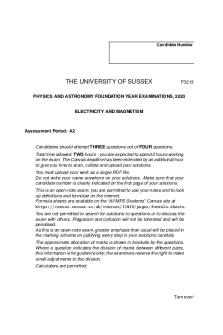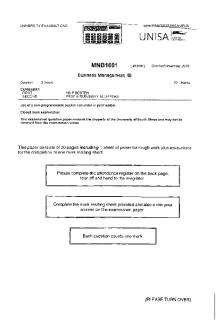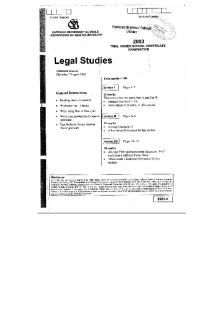9701 m16 qp 12 - past paper PDF

| Title | 9701 m16 qp 12 - past paper |
|---|---|
| Author | mariana li |
| Course | Basic Chemistry 2 |
| Institution | Universitas Indonesia |
| Pages | 16 |
| File Size | 392 KB |
| File Type | |
| Total Downloads | 38 |
| Total Views | 147 |
Summary
past paper...
Description
Cambridge International Examinations Cambridge International Advanced Subsidiary and Advanced Level
9701/12
CHEMISTRY Paper 1 Multiple Choice
February/March 2016 1 hour
Additional Materials:
*4624495401*
Multiple Choice Answer Sheet Soft clean eraser Soft pencil (type B or HB is recommended) Data Booklet
READ THESE INSTRUCTIONS FIRST Write in soft pencil. Do not use staples, paper clips, glue or correction fluid. Write your name, Centre number and candidate number on the Answer Sheet in the spaces provided unless this has been done for you. DO NOT WRITE IN ANY BARCODES. There are forty questions on this paper. Answer all questions. For each question there are four possible answers A, B, C and D. Choose the one you consider correct and record your choice in soft pencil on the separate Answer Sheet. Read the instructions on the Answer Sheet very carefully. Each correct answer will score one mark. A mark will not be deducted for a wrong answer. Any rough working should be done in this booklet. Electronic calculators may be used.
This document consists of 16 printed pages. IB16 03_9701_12/4RP © UCLES 2016
[Turn over
2 Section A For each question there are four possible answers, A, B, C, and D. Choose the one you consider to be correct. Use of the Data Booklet may be appropriate for some questions.
1
Which compound contains two different elements with identical oxidation states? A
2
3
B
Mg(OH)2
C
Na2SO4
D
NH4Cl
For the element sulfur, which pair of ionisation energies has the largest difference between them? A
third and fourth ionisation energies
B
fourth and fifth ionisation energies
C
fifth and sixth ionisation energies
D
sixth and seventh ionisation energies
Which ion has both more electrons than protons and more protons than neutrons? 1 2 [H = 1 H; D = 1 H; O = 168 O] A
4
HCl O
–
D
B
H 3O+
C
OD–
D
OH–
D
He+
Which species contains the smallest number of electrons? A
B 3+
© UCLES 2016
B
Be2+
C
H–
9701/12/F/M/16
3 5
Nitric oxide, NO, and bromine vapour react together according to the following equation. 2NO(g) + Br2(g) → 2NOBr(g)
ΔH o= –23 kJ mol–1
The reaction has an activation energy of +5.4 kJ mol–1. What is the correct reaction pathway diagram for this reaction?
A
B
EA enthalpy / kJ mol–1
enthalpy / kJ mol–1
EA
∆H o
∆H o
extent of reaction
extent of reaction
C
D
EA
EA enthalpy / kJ mol–1
enthalpy / kJ mol–1
∆Ho
extent of reaction
6
7
∆H o
extent of reaction
Which series shows molecules in order of increasing bond angle? A
CH4 → BF3 → NH3
B
H2O → CO2 → BF3
C
NH3 → CH4 → CO2
D
NH3 → CH4 → H2O
What is the volume of steam produced when 1.00 g of ice is heated to 323 °C at a pressure of 101 kPa? A
0.27 dm3
© UCLES 2016
B
1.3 dm3
C
2.7 dm3
9701/12/F/M/16
D
48 dm3
[Turn over
4 8
Solid carbon dioxide, CO2, is similar to solid iodine, I2, in its structure and properties. Carbon is in Group 14. Silica, SiO2, is a Group 14 compound. Which statement about solid CO2 and solid SiO2 is correct?
9
A
Both solids exist in a lattice structure.
B
Both solids have a simple molecular structure.
C
Both solids have atoms joined by single covalent bonds.
D
Both solids change spontaneously to gas at s.t.p.
An article in a science magazine contains the following statement. ‘It is lighter than a feather, stronger than steel, yet incredibly flexible and more conductive than copper.’ Which form of carbon is being described? A
buckminsterfullerene
B
diamond
C
graphene
D
graphite
10 Which equation has an enthalpy change of reaction which corresponds to the standard enthalpy change of atomisation of chlorine? A
1 2
Cl 2(g) → Cl (g)
B
1 2
Cl 2(l) → Cl (g)
C
Cl 2(g) → 2Cl (g)
D
Cl 2(l) → 2Cl (g)
11 In an experiment, 2.00 mol of hydrogen and 3.00 mol of iodine were heated together in a sealed container and allowed to reach equilibrium at a fixed temperature. The container had a fixed volume of 1.00 dm3. At equilibrium, there were 2.40 mol of iodine present in the mixture. H2(g) + I2(g)
2HI(g)
What is the value of the equilibrium constant, Kc? A
0.107
© UCLES 2016
B
0.357
C
0.429
9701/12/F/M/16
D
2.33
5 12 Consecutive elements X, Y and Z are in Period 3 of the Periodic Table. Element Y has the highest first ionisation energy and the lowest melting point of these three elements. What are the identities of X, Y and Z? A
sodium, magnesium, aluminium
B
magnesium, aluminium, silicon
C
aluminium, silicon, phosphorus
D
silicon, phosphorus, sulfur
13 When dealing with a spillage of metallic sodium it is important that no toxic or flammable products are formed. Which material should be used if there is a spillage of metallic sodium? A
dilute hydrochloric acid
B
ethanol
C
sand
D
water spray
14 Chlorine gas is widely used to treat contaminated water. Which species present in water when chlorine gas has been added is responsible for killing bacteria? Cl O2–
A
B
Cl –
C
HCl
D
OCl –
15 Which row of the table is correct? shape
bonds present
ammonia molecule
ammonium ion
ammonia molecule
ammonium ion
A
pyramidal
regular tetrahedral
σ
σ
B
pyramidal
regular tetrahedral
σ
π
C
regular tetrahedral
pyramidal
σ
σ
D
regular tetrahedral
pyramidal
π
σ
© UCLES 2016
9701/12/F/M/16
[Turn over
6 16 Hydrogen chloride gas and hydrogen iodide gas have different thermal stabilities. The difference is due to a difference in the energies of some of the covalent bonds that are involved in the decomposition. Which row identifies the more stable of the two compounds, and gives the correct explanation? identity of the more thermally stable compound
explanation for the difference in stability
A
hydrogen chloride
the Cl–Cl bond is stronger than the I–I bond
B
hydrogen chloride
the H–Cl bond is stronger than the H–I bond
C
hydrogen iodide
the Cl –Cl bond is stronger than the I–I bond
D
hydrogen iodide
the H–Cl bond is stronger than the H–I bond
17 Ammonium sulfate, (NH4)2SO4, and ammonium nitrate, NH4NO3, are used as fertilisers. These salts have different percentages by mass of nitrogen. They have the same effect as each other on the pH of neutral soil. Which row is correct? higher percentage of nitrogen by mass
effect on pH of soil
A
ammonium nitrate
decrease
B
ammonium nitrate
increase
C
ammonium sulfate
decrease
D
ammonium sulfate
increase
18 River water in a chalky agricultural area contains Ca2+, Mg2+, CO32–, HCO3–, Cl − and NO3– ions. In a water treatment plant, such water is treated by adding a calculated quantity of calcium hydroxide. What will be precipitated from the river water following the addition of calcium hydroxide? A
CaCl 2
© UCLES 2016
B
CaCO3
C
Ca(NO3)2
9701/12/F/M/16
D
Mg(NO3)2
7 19 After black and white photographic film has been developed, unreacted silver bromide is removed by reaction with sodium thiosulfate. AgBr + 2Na2S2O3 → 4Na+ + Br – + [Ag(S2O3)2]3– What is the function of the thiosulfate ion? A
to make the silver ions soluble
B
to oxidise the silver ions
C
to reduce the bromine
D
to reduce the silver ions
20 People who take statin drugs to control their blood cholesterol may also take ‘coenzyme Q10’. The diagram shows a simplified structure of one form of this coenzyme.
O CH3O
H
CH3O O
n
coenzyme Q10 Which row describes this structure correctly? the coenzyme is
number of π bonds in one molecule
A
an aldehyde
n+2
B
an aldehyde
n+4
C
a ketone
n+2
D
a ketone
n+4
© UCLES 2016
9701/12/F/M/16
[Turn over
8 21 Geraniol and nerol are compounds found in some flower fragrances. They are isomers of each other.
CH3
CH3
C H 2C
C
CH2OH C
H 2C
H
CH2OH
H 2C
H 3C C H 3C
H 2C
H 3C
C
C H
C
H 3C
geraniol
chain
B
geometrical (cis-trans)
C
optical
D
positional
22 A section showing two repeat units of an addition polymer is shown.
CH3 CH3 CH3 CH3 C
C
C
Cl
CH3 Cl
C CH3
What is the identity of the monomer that produced this polymer? A
2-chloro-3-methylbutane
B
2-chloro-3-methylbut-2-ene
C
2-chloropent-2-ene
D
2,4-dichloro-3,3,4,5-tetramethylhexane
© UCLES 2016
H nerol
Which type of isomerism is shown here? A
H C
9701/12/F/M/16
9 23 But-2-ene-1,4-diol is converted in two steps through an intermediate X into oxobutanedioic acid.
HOCH 2CH=CHCH 2 OH
step 1
step 2
X
hot, acidified KMnO4
but-2-ene-1,4-diol
HO2 CCOCH2 CO2 H oxobutanedioic acid
What could be the reagent for step 1 and what is the intermediate X? reagent for step 1
X
A
cold, acidified KMnO4
HOCH2CH2CH(OH)CH2OH
B
hot, acidified K2Cr2O7
HO2CCH=CHCO2H
C
steam and concentrated H2SO4
HOCH2CH(OH)CH2CH2OH
D
warm, acidified K2Cr2O7
OHCCH(OH)CH2CHO
24 Hydrogen bromide can be added to T to give compound U. Compound U can be hydrolysed to compound V.
step 1
step 2 Br
T
OH
U
V
Four students, W, X, Y and Z, made the following statements. W
All the atoms in a molecule of compound T lie in the same plane.
X
Compound V contains only one chiral centre.
Y
Step 1 is an electrophilic addition reaction.
Z
Step 2 is a nucleophilic substitution reaction.
Which two students are correct? A
W and Y
© UCLES 2016
B
W and Z
C
X and Y
9701/12/F/M/16
D
Y and Z
[Turn over
10 25 Structural isomerism and stereoisomerism should be considered in answering this question. Compound J is reacted with KOH dissolved in ethanol. Three isomeric alkenes with molecular formula C4H8 are formed. What is J?
A
CH3
CH 2
CH2
CH 2
B
CH3
CH
CH2
CH3
CH2
Br
Br
Br C
CH3
CH CH 3 CH 3
CH3
D
C
Br
CH 3
26 Which row correctly shows a primary, a secondary and a tertiary alcohol?
primary
A
B
C
D
CH 3
CH 3
CH 3
tertiary
CH2 OH
CH2OH
CH2OH
CH2
CHOH
CHOH
CH3
CH3
CH2OH
CH2 OH
CH3
CH3
C
H
CH3
C
OH
CH3
C
H
CH3
CH3
CH2OH
CH2 OH
CH2OH
CH2OH
C
H
CH3
C
CH2OH
CH3
C
CH2 OH
H
H
CH2OH
H
CH3
CH3
C H
© UCLES 2016
secondary
OH
CH3
C
OH
H
CH3
C CH3
9701/12/F/M/16
OH
11 27 The fragrance compounds of perfumes are often dissolved in solvent Y, which has a molecular formula C7H12O4. It is made by reacting propane-1,2-diol with ethanoic acid in the presence of an acid catalyst.
HO
H
CH3
C
C
H
H
OH
propane-1,2-diol What is the structure of solvent Y?
A O C
O
H3C
B
H
CH3
C
C
H
H
O
O
C
C O
CH3
H 3C
O
H
CH3
C
C
H
H
C H3C
O
C O
CH3
D
C O
O
H
CH3
C
C
H
H
O O
O
C
C
O
H 3C
CH 3
H
CH3
C
C
H
H
O O
C CH3
28 Which mixture could be used to produce propyl methanoate? A
CH3CH2CO2H and CH3OH
B
CH3CH2CH2CH2OH and HCO2H
C
CH3CH2CH2OH and HCO2H
D
CH3CH2CH2CO2H and CH3OH
29 Which statement about poly(chloroethene) is correct? A
The polymer can be cracked to produce chlorinated alkenes.
B
The polymer has harmless combustion products.
C
The polymer is readily biodegradable when buried.
D
The repeat unit of the polymer has an Mr of 97.
© UCLES 2016
9701/12/F/M/16
[Turn over
12 30 Which row of the table is correct? increasing number of carbon atoms A
ethyl methanoate
methyl propanoate
pentyl pentanoate
propyl butanoate
B
ethyl methanoate
methyl propanoate
propyl butanoate
pentyl pentanoate
C
methyl propanoate
propyl butanoate
ethyl methanoate
pentyl pentanoate
D
propyl butanoate
ethyl methanoate
pentyl pentanoate
methyl propanoate
© UCLES 2016
9701/12/F/M/16
13 Section B For each of the questions in this section, one or more of the three numbered statements 1 to 3 may be correct. Decide whether each of the statements is or is not correct (you may find it helpful to put a tick against the statements that you consider to be correct). The responses A to D should be selected on the basis of A
B
C
D
1, 2 and 3 are correct
1 and 2 only are correct
2 and 3 only are correct
1 only is correct
No other combination of statements is used as a correct response.
31 Which molecules have an overall dipole moment? 1
carbon monoxide, CO
2
phosphine, PH3
3
carbon dioxide, CO2
32 The diagram illustrates the enthalpy changes of a set of reactions
R
∆H = –134 kJ mol–1
S
∆H = +92 kJmol–1
T
∆H = –75 kJ mol–1
U
Which statements are correct? 1
The enthalpy change for the transformation U → R is + 42 kJ mol–1.
2
The enthalpy change for the transformation T → S is endothermic.
3
The enthalpy change for the transformation R → T is – 33 kJ mol–1.
© UCLES 2016
9701/12/F/M/16
[Turn over
14 The responses A to D should be selected on the basis of A
B
C
D
1, 2 and 3 are correct
1 and 2 only are correct
2 and 3 only are correct
1 only is correct
No other combination of statements is used as a correct response.
33 Which statements about reversible reactions are correct? 1
An increase in concentration of a reactant always increases the concentration of the product.
2
An increase in temperature always increases the rate at which the equilibrium is established.
3
An increase in temperature always increases the concentration of the product at equilibrium.
34 A chemist puts a sample of dilute aqueous hydrochloric acid into beaker 1. She adds a sample of zinc and measures the rate of production of hydrogen gas. She then puts a different sample of dilute aqueous hydrochloric acid into beaker 2. She adds a different sample of zinc and measures the rate of production of hydrogen gas. The rate of the reaction in beaker 2 is greater than the rate of the reaction in beaker 1. Which factors could help to explain this observation? 1
<...
Similar Free PDFs

9701 m16 qp 12 - past paper
- 16 Pages

9701 s13 qp 13
- 16 Pages

AQA 71321 QP JUN17 - Past Exam Paper
- 24 Pages

9626 w20 qp 12 - NHHHJ
- 20 Pages

June 2018 QP - Exam paper
- 48 Pages

QP
- 1 Pages

Uob past paper
- 4 Pages

Legal Studies Past paper
- 18 Pages

STAT270 - past exam paper
- 24 Pages

Macroeconomics Past Paper
- 12 Pages

2020 F3213 - Past paper
- 5 Pages

Past exam Paper 2018
- 23 Pages

Trial past exam paper
- 7 Pages

ANAT2004 2019 past paper
- 16 Pages

MA103 Past Paper Exam
- 5 Pages
Popular Institutions
- Tinajero National High School - Annex
- Politeknik Caltex Riau
- Yokohama City University
- SGT University
- University of Al-Qadisiyah
- Divine Word College of Vigan
- Techniek College Rotterdam
- Universidade de Santiago
- Universiti Teknologi MARA Cawangan Johor Kampus Pasir Gudang
- Poltekkes Kemenkes Yogyakarta
- Baguio City National High School
- Colegio san marcos
- preparatoria uno
- Centro de Bachillerato Tecnológico Industrial y de Servicios No. 107
- Dalian Maritime University
- Quang Trung Secondary School
- Colegio Tecnológico en Informática
- Corporación Regional de Educación Superior
- Grupo CEDVA
- Dar Al Uloom University
- Centro de Estudios Preuniversitarios de la Universidad Nacional de Ingeniería
- 上智大学
- Aakash International School, Nuna Majara
- San Felipe Neri Catholic School
- Kang Chiao International School - New Taipei City
- Misamis Occidental National High School
- Institución Educativa Escuela Normal Juan Ladrilleros
- Kolehiyo ng Pantukan
- Batanes State College
- Instituto Continental
- Sekolah Menengah Kejuruan Kesehatan Kaltara (Tarakan)
- Colegio de La Inmaculada Concepcion - Cebu
